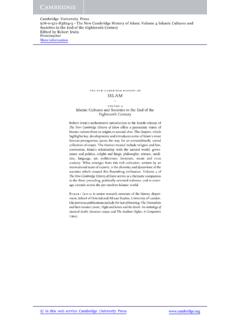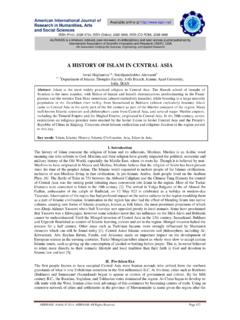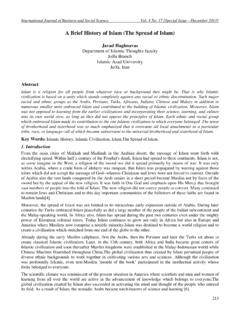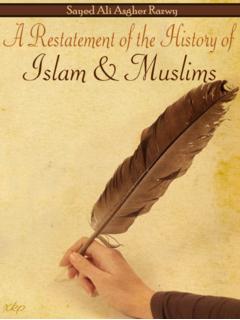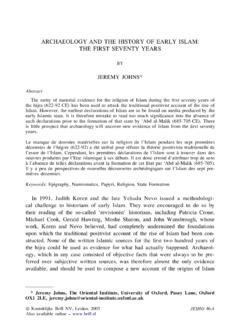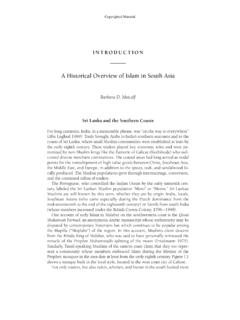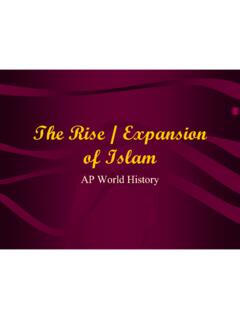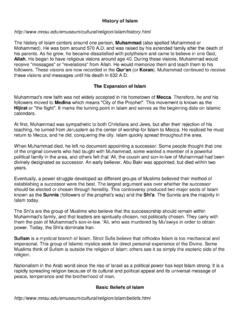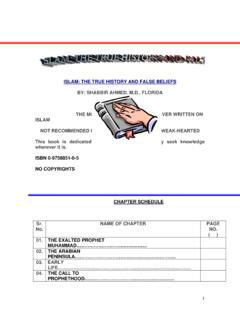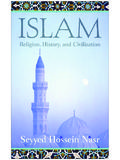Transcription of Islamic History and Civilization, 600-1200, C - HIS - UNCG
1 Introduction to Islamic History and civilization , 600-1200 Topics in Pre-Modern World History Fall 2009 HIS 207-05, Tuesdays and Thursdays 12:30-1:45 PM HIS 207-06, Tuesdays and Thursdays 3:30-4:45 PM Instructor: A. Asa Eger Office: MHRA Building, Room 2108 Office Hours: Tuesday and Thursday 2:00-3:00 PM Office Phone: 336-334-3986 Description: In the middle of the seventh century, Arab tribes coalesced and emerged from the Arabian Peninsula, conquering an enormous expanse of territory that reached from the shores of the Atlantic Ocean to the deserts of India in less than one hundred years.
2 In the following centuries, Islamic civilization took shape, a dynamic process framed by Islamic ideals yet influenced by the many cultures this civilization embraced. The products of this civilization included magnificent monuments, extensive works of literature and science, far-flung trade routes that connected to east Asia, and new agricultural and technological innovations. This course will familiarize students with the History of the rise and spread of Islamic civilization as a complex and interdependent process that occurred throughout the Near East, North Africa, Spain, and Central Asia. We contextualize this process in the world before islam and the rise of the Prophet Muhammad at the start of the seventh century and continue until the time of the Crusaders at the end of twelfth century.
3 Our approach will be interdisciplinary. We will look at the History , art and architecture, archaeology, environment, literature, and religion of Islamic civilization . Student Learning Objectives: Students will be able to identify the major periods, events, terms, and facts of Islamic History until 1200 They will express understanding of some key concepts and theories that contributed to the formation of islam : they will be able to describe the historical, geographic, aesthetic, and religious contexts for the rise of islam and explain various motivations for the conquests and spread of islam . Students will also be able to trace the developments of Islamic civilization through various examples of cultural and social production.
4 By developing an informed historical perspective and by reflecting on the dynamic between Western and non-Western experience, students will be able to challenge and historicize current ideas and stereotypes of islam . 1 Requirements: There will be two 75 minute classes per week. Each class will consist of approximately a 60 minute lecture followed by 15 minutes for class discussion and questions. Please read the assigned materials during the week assigned and come to classes prepared with questions and observations. Attendance is required, as lectures will frequently include material not covered in the assigned readings, for which you will also be responsible for on exams.
5 No prerequisite is required to take this course. Readings: Readings for each week are given on the attached syllabus. Readings listed under the lecture mean you will have read those in advance for that lecture day. Weekly assignments consist of readings from selected works. Please come prepared and able to comment on the readings in class. In addition to the assigned readings, additional readings have been placed on reserve and will be useful for those wishing to explore subjects (particularly for papers) in detail. Lecture handouts will accompany most lectures and will provide an outline and, especially, terms and dates referred to in the lecture.
6 These terms may also appear on your exams. Use these handouts as review sheets for exams. Study aids, though not a requirement for the course, might be useful in preparing for exams, researching the group assignment, and providing useful basic reference information for Islamic History and civilization . They include: The Encyclopaedia of islam (First Edition (EI1), 1913-1942, New (Second) Edition (EI2), 1954 (1960)-2004, Third Edition, continuing). Jackson Library stacks Tower 8 , vols. 1-12. The Cambridge History of islam . Jackson Library stacks Tower 8 , vols. 1-2 Bosworth, C. E., The Islamic Dynasties. Jackson Library stacks Tower 8 No. 5 Required text: (used and new copies available from bookstore) Kennedy, Hugh.
7 The Prophet and the Age of the Caliphates: the Islamic Near East from the Sixth to the Eleventh Century. Second Edition. NY: Longman Group Limited, 2004. Assignments: Map Assignment: There will also be a map assignment at the beginning of the course designed to introduce you to the geography of the Islamic world. You will be responsible for filling it out and will have one week to work on it. Examinations: There will be two examinations for the course. These will consist of a number of brief identifications, short answer, and essay questions. Most lectures will be accompanied by a handout providing an outline and including terms that occur in the literature and you may not be familiar with.
8 These terms will be useful to keep for review for the identification tests. 2 Group Assignment: A group research assignment will be given halfway through the semester. Your job is to become specialists in a region in the Islamic world. Using the Islamic geographers as a starting point, you will research your region including its cities, resources, roads, and anything else that you consider relevant ( History , art, archaeology). The purpose of the assignment is for you to: 1) read primary sources (in translation), 2) implement research skills and access resources, and 3) to develop your ability to communicate in written and verbal forms and collaborate by having you work in groups and give a public (in-class) presentation.
9 You will be in groups of 3-5 and present your regions at the end of the semester. A final paper will be turned in on the day of the presentation that is between 3-5 pages (800-1500 words, double spaced) and includes non-Internet references. Grading will be as follows: Attendance and Class Participation (10%), Map Assignment (10%), 2 exams (25% each), and group assignment (30%). Attendance is mandatory and I will take attendance at the beginning of each class. You may miss three classes during the semester, after which your class participation grade will be docked 3 points for each absence. If you miss more than six classes I reserve the right to drop you from the course.
10 All assignments must be turned in on time; those turned in late will not receive credit. If you must miss an exam you must let me know in writing before the date and there will be a make-up exam, otherwise you will receive a zero. Class Rules: Please do not come late to class as it disrupts the class for both your fellow classmates and for me. Cellular phones must be silenced or turned off in the classroom. If you disrupt class by talking on the phone or text messaging, you will be asked to leave. Laptops may not be used in the classroom. Please note that plagiarism (this includes copying internet text for papers), cheating, and other violations of academic integrity are serious offences and will not be tolerated in the class or anywhere else in the University.
